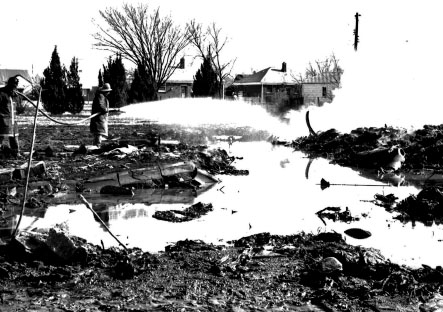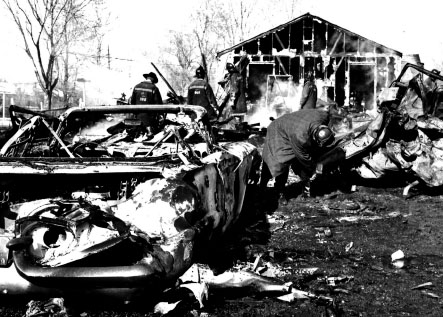Mayday Over Wichita (6 page)
Read Mayday Over Wichita Online
Authors: D. W. Carter

That day, Wichitans would realize, if they hadn't before, the true meaning of a firefighter as they watched dozens of Wichita's finest hurl themselves into the flames to preserve life, limb and property. Sonya House put it bluntly, “I learned what a firefighter was. They were fighting the fire, and that fire was fighting them back.”
93
Chief McGaugheyâarriving nine minutes after the plane hitâdescribed the pandemonium:

Firefighters carry a crash victim from the accident site.
22
nd
ARW History Office
.

Firemen spray flaming wreckage.
Larry Hatteberg
, KAKE TV.
All hell broke loose when the plane exploded upon impactâscattering fuel mixed with mud like napalm bombs over homes as far away as two thousand feet with the force of the blast. The speed and weight of the aircraft sent one of the motors crashing through the asphalt concrete street and six feet of soil to rupture an eight-inch water main and a three-inch natural gas line at the bottom of a crater approximately ten feet in diameter
.
94
The firemen and emergency responders heading into the blaze, without question, faced a warzone.
D
ISASTER
P
LAN
When it was confirmed that the emergency responders had a catastrophe on their hands, on a scale never before seen in Wichita, the disaster plan went into effect. According to Chief McGaughey, the first company arrived at 9:32 a.m. and radioed back to the firehouse, “There's a block and a half of houses burning; you had better make it a double.”
95
The first alarm came in at 9:30 a.m., the second at 9:32 a.m. and the third at 9:38 a.m.âwhich alerted the off-duty firemen to respond as well. Chief McGaughey also called for all of the available ambulances and the coroner to head to the scene, while checking with dispatch to make sure the disaster plan was initiated.
96
The initiation of the plan meant that all police and fire reserves were activated; the American Red Cross was notified; hospitals, ambulance crews and medical personnel were put on standby; second alarm companies were sent out; and the Heavy Rescue and Fire Reserve were alerted.
97
The Boeing and McConnell Fire Departments were already rushing to the scene after they were notified of Raggy 42's mayday call and saw the smoke billowing from northeast Wichita. Meanwhile, calls from frantic citizens began to light up the switchboard reporting the inferno.
Nearly two hundred homes were blacked out by power loss when the plane hit. Wichita firemenâa few blocks away at 17
th
and Grove Streetâquickly discovered they were trapped inside Fire Station 10, the heavy garage doors immobilized by the power outage. They had to pull the pins on the giant doors and lift them manually just to get the engine out.
98
Arriving in the area a few minutes later, they faced the lake of fire on Piatt Street caused by broken water mains and burning jet fuel floating on top. The blazing liquid extended for nine hundred feet in the immediate area, making it nearly impossible for the firemen to access homes. The debris of four houses, scattered across Piatt Street, further obstructed the path of the fire engines.

Firemen search rubble.
Larry Hatteberg
, KAKE TV.

Firefighters search through wreckage.
Larry Hatteberg
, KAKE TV.
To add to these obstacles, downed power lines electrified many of the wire fences surrounding backyards, shocking anyone who touched them. Firemen became “jumping jacks” as they straddled the fences and were jolted with electricity.
99
Residents hastily retrieving their cars, sightseers and crowds blocked other ways of entry. Those left alive who were suffering from burns, lacerations from flying debris or shock were treated by the emergency responders.
After the impact, the force of the explosion was pushed southwest of the 20
th
and Piatt intersection. Most of the homes there were constructed of wood, which fueled the consuming fire. As Chief McGaughey explained, “[A]ll homes on the west side of the street were wood frame; homes on the east side were all brick veneer,” which allowed the flaming jet fuel not only to swiftly torch the exterior but also to push its way inside “as if from a giant atomizer,” melting the interior.
100
The firemen dousing the five-hundred-foot-high flames noted how, when they breathed, “it almost tasted like [they] were drinking jet fuel.”
101
Deputy Chief Simpson, remembering the conflagration, commented:
I have never seen so much fire in so many places. It just licked every place up and down the street. There was no way of telling just how many houses were on fire. It appeared to me that the fire was in the houses, burning from the inside out, rather than so much fire on the outside of the houses. I guess this is because the fuel was sprayed into them, and, of course, the contents of the building had ignited
.
102
The homes in the impoverished neighborhood, most of which cost no more than $10,000, never stood a chance.
R
ESOURCES
In 1965, twenty-seven companies located in thirteen fire stations made up the WFD with approximately 100 firefighters on duty each day. One district chief oversaw three response districts. Wichita firefighters worked sixty-six-hour workweeks then, alternating between twenty-four hours on and twenty-four hours off.
103
Chief McGaughey called in as many men as he could to do battle with the fire along with their hulking equipment. The WFD used a total of “11,000 feet of 24-inch hose, 2,000 feet of 13-inch hose, 42 on-duty personnel and 136 off-shift firemen” to address the warzone at 20
th
and Piatt.
104
Equipment response included: seven engine companies from WFD, including one aerial company and the emergency bus that was used as a command post; one engine company from Fire Reserve; two engine companies from the County Fire Department; five units from Heavy Rescue; a tanker and foam truck from McConnell Fire Department; and one Boeing semi-trailer tanker that produced foam from two blabbermouth nozzles mounted on top of the unit.
105
It took an army of men and equipment to combat the blaze, and the determination of the firefighters was nothing short of amazing.

A 1965 map of the Piatt Street crash showing damaged homes (retyped for clarity).
U.S. Air Force Safety Center, Kirtland Air Force Base, New Mexico
Chief McGaughey and his men made their attack from the perimeter and marched toward the center of the fire. It was a portrait of combatâwith the chief leading his men in a coordinated strike against a ferocious enemy. They waged war on the blaze from all directions in a synchronized effort to jostle the flames “back toward the impact point,” recounted Chief McGaughey, so that they could start drenching the burning houses. When the McConnell and Boeing equipment arrived, they blasted the fire with foam, while county pumpers swept the adjoining streets and area, putting out “grass and roof fires caused by flaming chunks of mud saturated with JP4 (much like napalm)” that had been blown over the entire area. For the firemen, it was warfare.
106
The community also fought against the fire. Two off-duty captains and firefighters who lived in the area of 20
th
and Piatt assisted from their homes to direct the incoming firemen. Volunteers helped clear victims from the area, and neighbors assisted in manning hose lines, causing Chief McGaughey to realize that, “although many people were in a state of shock, we had so much citizen help that 24-inch hose lines were moved about as if they were booster lines [much smaller and lighter hoses].”
107
The citizens in the immediate area who were not assisting the firemen were moved back by the police for their safety. Fourteen Wichita police officers initially responded, just minutes after the plane hit. That number quickly ballooned into hundreds of law enforcement personnel, including the Wichita Police Department (WPD), Sedgwick County Sheriff's Office, Kansas Highway Patrol, McConnell military police officers, National Guard and Army Reserves. Chief E. M. Pond, of the WPD, dispatched one WPD officer for every three military police officers from McConnell. The first perimeter established by the WPD stretched south from 21
st
Street to 13
th
Street (one mile) and from Hydraulic Street east to Grove Street (one half mile).
108
Although there was a need for crowd control to prevent onlookers from contaminating the scene or removing evidence, no arrests were made on January 16. Chief Pond would later praise how “local residents participated in traffic control and lessened spectator congestion, easing the difficulties of apparatus in getting to the scene.”
109
Cooperation between the community and law enforcement was seamless.
C
ONTAINMENT
The enormous firestorm was under control by 9:55 a.m., twenty-four minutes after it began.
110
In forty-five minutes, electrical service was restored, thanks in part to utility companies that labored intensely to restore electrical and gas service, recover downed power lines and seal off an eight-inch water main severed by the plane on impact.
111
Although firemen would continually soak the wreckage for several hours after the crash, it was at least contained at that point by the steady flow of foam and water pouring out from fire trucks in all directions.
112
